Doto spp.
unidentified Caribbean
Order: NUDIBRANCHIA
Suborder: DENDRONOTINA
Family: Dotidae
At present the Caribbean species of Doto are difficult to identify so I am placing most of them here until I get some expert advice. Dr Ortea's has recently described a number of new species and partially reviewed earlier species descriptions for the western Atlantic. This valuable addition to our knowledge gives us some information on the food choice of various species but until we know more about variability within a species I don't feel competent to make identifications from photographs.
-
Ortea, J. (2001). The genus Doto Oken, 1815 (Mollusca: Nudibranchia) in the Caribbean sea: Natural History and new species description (in Spanish). Avicennia Supplement 3: 1-46.
Rudman, W.B., 2009 (June 3) Doto spp. unidentified Caribbean. [In] Sea Slug Forum. Australian Museum, Sydney. Available from http://www.seaslugforum.net/find/dotocarib
Related messages
Nudibranchs on Sargassum
May 20, 2010
From: David M. Knott
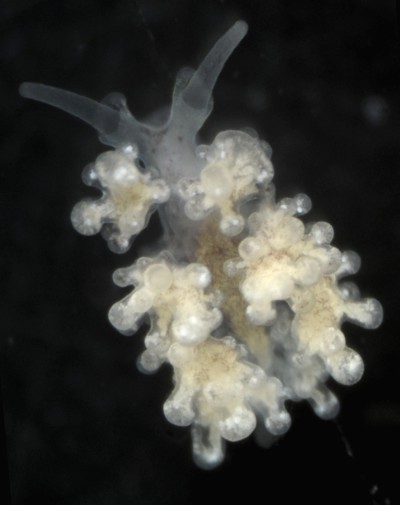
Here is a nudibranch that we've photographed for a poster we are preparing on the faunal associates of Sargassum. I think I've come close to getting and ID on it, but I find it impossible to track down the latest taxonomic word on synonymies. Can someone (Bill?) tell me what the currently accepted name is for this species? It was collected in late April/early May while dipnetting Sargassum off the coast of South Carolina.
on surface, off South Carolina, South Atlantic Bight, USA, May 2010, on Sargassum fluitans or S. natans. Length: 2-3 mm. Photographer: Susan DeVictor, SERTC.
David M. Knott
knottd@dnr.sc.gov
Knott, D.M., 2010 (May 20) Nudibranchs on Sargassum. [Message in] Sea Slug Forum. Australian Museum, Sydney. Available from http://www.seaslugforum.net/find/23645Dear David,
Your animal is clearly a species of Doto. I am afraid the species of the genus Doto are difficult to identify even in regions such as NW Europe where they are relatively well known. Although some species seem to be easy to distinguish and morphology and colour from others, it seems there are quite a few with very similar colour patterns and shape to other species, and seem to differ on choice of hydroid they feed on. The other problem, is well illustrated by where you found your animal - some species seem to have global distributions - perhaps through misidentifications around the world - or because they are well adapted for 'rafting' on flotsam and floating algae such as Sargassum.
On top of this the nudibranch fauna of the Atlantic coast of Nth America is not well known. You say you are close to an ID. Perhaps if you let us know what you are thinking we could give an opinion on your choice. It has similarities to the tropical west Atlantic Doto pita but it just as well could be a north Atlantic species at the sthn extreme of its range. Hopefully someone closer to the Atlantic can give an opinion
Best wishes,
Bill Rudman
Re: Doto uva from Jamaica
June 3, 2009
From: Linda Ianniello
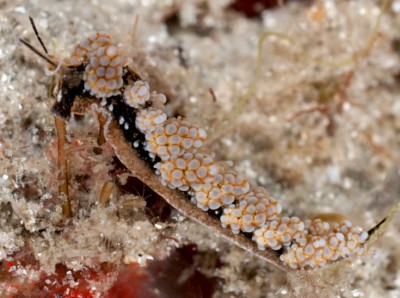
Concerning message #11116:
Dr. Bill,
here are three images of what I believe are Doto uva. But as you said, these need some work. But it seems to match the one shown in the "Caribbean Sea Slugs".
Locality: Lake Worth Lagoon, 20 feet, Florida, USA, Atlantic, Tidal intracoastal. Length: 0.5 inch. Photographer: Linda Ianniello.
Regards,
Linda
lindai1@bellsouth.net
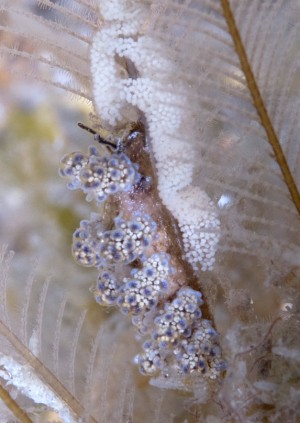
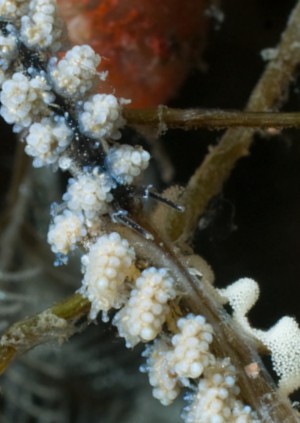
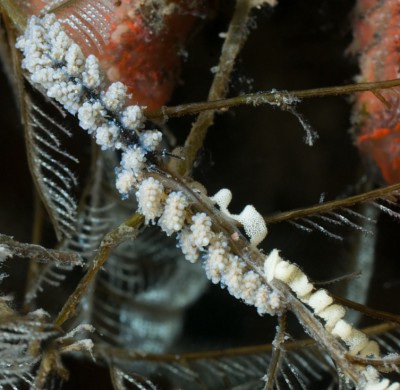
Dear Linda,
Yes I did say before that I don't know how anyone can confidently identify this species which was described from a single 4.5 mm long specimen from Brazil. Your upper animal does look like the one that is identified as D. uva in Caribbean Sea Slugs but I can't really see how they came to that conclusion on the very little we know about that species. In some ways Ortea's 2001 paper clarifies the situation, but in other ways it complicates it.
It makes me wonder whether your three photos represent 3 different species! Your animal in the lower photo [and middle right close-up] reminds me a bit of the Pacific species, Doto ussi, which has been reported to live on the stinging hydroid Aglaophenia cupressina. Interestingly your animal also seem to be living on one of the thick-stalked species of hydroid. I wouldn't be surprised if this is Marcus's Doto divae from the scalloped edge to the rhinophore sheath.
And the animal in the middle left photo looks quite like Ortea's illustrations of Doto cabecar. Hopefully Dr Ortea could give us his opinion on these species. There is little point in me making hopeful guesses so I am putting your message on an unidentified Caribbean Doto page. Hopefully it won't stay there long.
Please continue to photograph them on their hydroid prey and if you are lucky enough to find them with their egg masses, I am sure your photos will be a valued asset for future researchers.
-
Ortea, J. (2001). The genus Doto Oken, 1815 (Mollusca: Nudibranchia) in the Caribbean sea: Natural History and new species description (in Spanish). Avicennia Supplement 3: 1-46.
Best wishes
Bill Rudman
